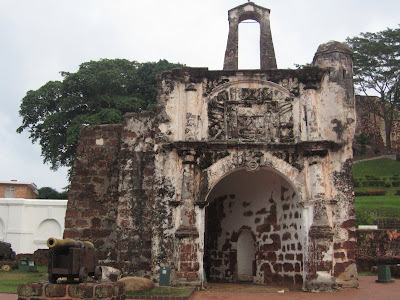
the portuguese settlement at ujong pasir, 5km from melaka town. a few restaurants there include papa joe, de lisbon and celine cafe. when we were there in the morning at 10 a.m. on a monday, all the shops and restaurants were not open for business yet.

we were attracted by the colourful trishaws that were parked near the stadthuys. built by the dutch in 1650s, after having taken over from the portuguese, this architectural structure is the oldest dutch building in the east. the building was originally white in colour but was later painted salmon red, in 1820’s, to match with the colour of the nearby christ church.

the dutch graveyard was first used in the last quarter of the 17th century. 5 dutch and 33 british graves are sited within its compound. the grave that attracts the attention of most visitors is the one with a tall column. two army officers who were killed during the naning war lie buried in this grave.

melaka sultanate palace (relica) built based on the description and reference to the palace in sejarah melayu' - the malay annals. situated at thhe foot of st paul's hill.

st paul's church was formerly a chapel built by a portuguese captain by the name of duarte coelho. st francis xavier, who died off the coast of china in 1552, was briefly enshrined in an open grave here before being shipped to goa in india. his statue was erected in melaka with his right arm missing, apparently to show that his body in goa is still without the right arm.

an iconic image of melaka. built by the portuguese in 1511 as a fortress, it sustained severe structural damage during the dutch invasion. the british destroyed most of the fort but the intervention by sir stamford raffles in 1808 saved what remains of a' famosa.
during my 3-day stay in melaka, i went for my morning walk, at around 6.45 a.m., on two mornings around the st paul's hill area. came across a number of groups doing tai chi and other forms of exercises.





No comments:
Post a Comment